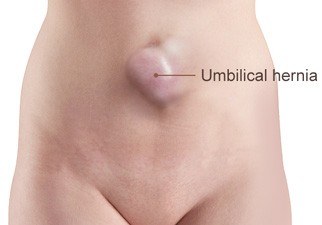Umbilical Hernia
What is an umbilical hernia?
A hernia is a bulge that has formed when the internal organs of the body push through a weak spot in the abdominal wall. Umbilical (paraumbilical) hernia is the bulge that forms near the navel or belly button, when a part of the intestine, fat or fluid is pushed out through a weakened muscle of the abdomen. Umbilical hernia can be found in both children and adults.
What causes an umbilical hernia?
Umbilical hernia is commonly caused in infants and young children, especially in premature babies. The umbilical cord passes through a small muscular opening in the baby's abdomen during pregnancy. Sometimes, the muscles of the umbilical opening fail to close completely after birth. This leads to a weak spot near the navel, which allows the internal organs of the abdomen to push through it.
People with various health issues that can put pressure on the abdomen, such as being overweight, multiple pregnancies, having ascites (excessive fluid in the belly), are prone to developing an umbilical hernia. Other situations such as lifting heavy objects, straining on the abdominal muscles during constipation or coughing.

What are the signs and symptoms of umbilical hernia?
The main symptom of an umbilical hernia is the presence of a swelling or bulge near the navel, which ranges from 1 to 5 cm in diameter.
The bulge may be noticeable in babies when they cough, cry or strain the abdomen, and may wane off or reduce while lying down or staying calm. This hernia is generally not painful in children. However, umbilical hernias in adults may cause pain, discomfort and increase in size over time.
How is an umbilical hernia diagnosed?
To diagnose an umbilical hernia, your doctor will review your symptoms and your medical history.
Physical examination is generally conducted to determine the size and prominence of the umbilical hernia. Your bulge will be examined when you are standing and lying down. Your doctor may try to reduce the bulge by pushing it inside your abdomen, and will ask you to cough to see if there is any change in size of the bulge. Blood tests and imaging tests such as X-rays, MRI scan or CT scan may be ordered to confirm on the diagnosis.
What are the consequences of not treating an umbilical hernia?
Left untreated, umbilical hernias can get trapped and strangulated, thereby cutting off the blood supply to the trapped part. This may cause death of the trapped tissue (gangrene necrosis) and result in severe complications.
What are the options for umbilical hernia treatment?
In adults, a painful and enlarged bulge is usually treated with surgery. Surgery can prevent further complications of the hernia, which can occur due to strangulation. However, in children, the hernia generally resolves by 18 months. Your doctor may wait for a while before suggesting surgery.






